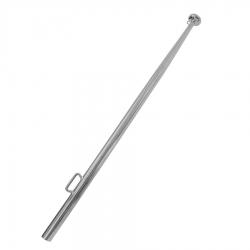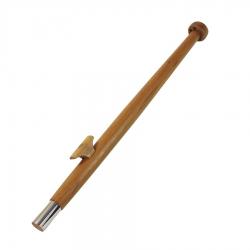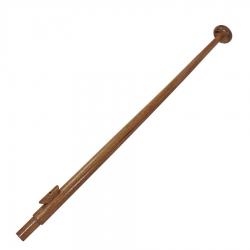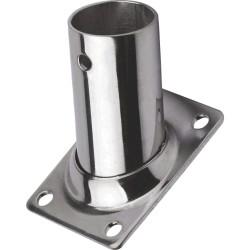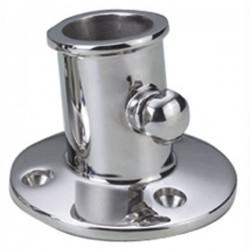Jimmy Green Marine offer a selection of stylish flagstaffs and smart flagstaff sockets to complement the Jimmy Green range of national ensigns.
Ensign or National Flag Etiquette dictates that a UK registered vessel should fly the national maritime flag - the Red Ensign, unless entitled to fly a special or privileged Ensign.
The Ensign (or National Flag) denotes the nationality of any sailing or motor yacht and it should be flown from the most senior position which is deemed as close to the stern as possible.
Ensigns are sometimes seen attached to all sorts of convenient positions near the transom e.g. backstays, solar panel supports, davits, gantries, but they look best flown from a proper flag staff.
Selection criteria for Ensign Flag Staffs:
- Material - choose a staff that will match in or stand out on your yacht according to your preferred style
- Finish - stainless steel will occasionally need a wash and a polish, hardwood will eventually need some atttention e.g. teak cleaner or a light rub down and varnish/lacquer
- Length - needs to be proportional to your preferred ensign
- Fit - ensure that the staff you choose is a good match for your existing socket/fixing point - select both staff and socket with compatibility in mind - most stainless steel staffs are 25mm outside diameter with matching 25mm internal diameter sockets available - hardwood staffs too, may have 25mm metal ferrules at the bottom - otherwise match the end of the staff diameter with the internal diameter of the socket - odd set ups may need a little ingenuity to ensure a firm fit e.g. insulation tape to take up any slack, a little shaving if the wood won't quite go in.
- Truck - the top of the staff may incorporate a roller, a hook or simply some holes for attaching the ensign - consider how you wish to secure the top of the hoist (loop or toggle) to the truck
- Cleat - this is essential to tension the tail of the hoist (the braided line that tails down from the leading edge of the flag)
Jimmy Green Flag Staffs for flying your national ensign are available in:
- Marine Grade Polished Stainless Steel
- Superb Plantation Teak Hardwood
- Lahna Finnish Mahogany Red Hardwood with special varnish finish
Jimmy Green Flag Staff Sockets provide the means to stand the flag staff up off the deck, toe rail or transom.
Flag Staff Sockets Important Decision Making Factors:
- Ensure that the flag staff and socket are compatible
- Is a locking pin or screw necessary ?
- The correct angle for your installation - raked rather than upright generally looks 'the part'
- Fixing - does your chosen position have good fastening potential ?
Flag Staff Fitting Options:
Jimmy Green offer stainless steel sockets that fix down to the deck/toerail/transom. There are other options for installing your flag staff according to how 'busy' it is around the aft deck and the pushpit rail. There can be a large amount of safety equipment, deck gear, dinghy davits, fender stowage vying for the available space. A short piece of stainless steel rod with a locating pin through-hole welded to your pushpit rail may be worth considering. There are flag staff sockets available that fit to the rail, but in our experience, they are not very robust, and they don't hold their position well, so we do not sell them. We would welcome any other ideas on suitable top quality options.
Attaching your Ensign to the Flag Staff
This usually requires a little ingenuity and some patience to ensure a neat, unobtrusive finish. Flag staffs should have a truck (bulbous head) at the top which has a pleasing appearance and also provides the means to attach the top corner of the ensign to the staff. The webbing-reinforced leading edge of the ensign is called the hoist. The Hoist Line is the braided cord which tails down from the reinforced, leading edge of the ensign. Ensigns will either have a loop or a loop with toggle fitted at the top of the hoist. Flagstaffs are fitted with cleats near the bottom which can be used to tension the leading edge of the flag by means of the hoist line.
Fiddly, but neat finishing examples:
A thin burgee cord could be secured to the top of the hoist, through the truck and attached to the end of the hoist tail, creating an endless control line which can be tensioned and secured on the cleat. It may be possible to pass the loop through the roller or the pre-drilled holes in the truck, and squeeze a toggle back in to the loop. You could form a loop (circle) with small diameter 8plait cord e.g. 3mm secured with a discreet, heat sealed knot or, even bettter, a whipping. The loop should be secured through the truck, popping out from the aperture (holes, roller or sheave) leaving just enough room to squeeze the toggle in, so that it nestles snug against the underside of the truck. The Jimmy Green stainless steel flagstaff has a convenient integral hook just below the truck If the ensign has no toggle, you could purchase one, or you can sheet bend your cord to the flag hoist loop and then form your cord into a loop, making sure that it engages with the truck, of course :-)
Burgee Cord Wooden Toggles
Main Menu
Main Menu
Back
Main Menu
Back
Main Menu
Back
Back
Main Menu
Back
Main Menu
Back
Back
Main Menu
Back
Main Menu
Main Menu
Back
Main Menu
Back
Back
Back
Back
Back
Back
Back
Back













